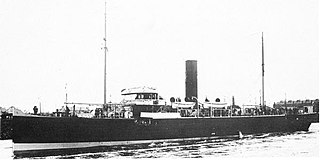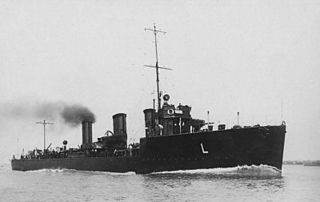| Ship | Builder | Launched [3] [4] | Fate |
|---|
| 1915 batch |
| P.11 | J. Samuel White & Company, Cowes | 14 October 1915 | Sold for breaking up 1 December 1921 |
| P.12 | White, Cowes | 4 December 1915 | Sunk in collision in the Channel 4 November 1918 [5] |
| P.13 | William Hamilton and Company, Port Glasgow | 7 June 1916 | Renumbered P.75 on 31 July 1917 and sold for breaking up 31 July 1923 |
| P.14 | Charles Connell and Company, Scotstoun | 4 July 1916 | Sold for breaking up 31 July 1923 |
| P.15 | Workman, Clark and Company, Belfast | 24 January 1916 | Sold on 26 November 1921 |
| P.16 | Workman Clark | 23 March 1916 | Sold on 26 November 1921 |
| P.17 | Workman Clark | 21 October 1915 | Sold on 26 November 1921 |
| P.18 | A. & J. Inglis, Glasgow | 20 April 1916 | Sold 26 November 1921 |
| P.19 | Northumberland Shipbuilding Company, Howdon | 21 February 1916 | Sold 24 July 1923 |
| P.20 | Northumberland Shipbuilding | 3 April 1916 | Sold for breaking up in May 1923 |
| P.21 | Russell & Company, Port Glasgow | 31 March 1916 | Sold 26 November 1921 |
| P.22 | Caird & Company, Greenock | 22 February 1916 | Sold for breaking up 12 December 1923 |
| P.23 | Bartram & Sons, [2] Sunderland | 5 March 1916 | Sold 24 July 1923 |
| P.24 | Harland & Wolff, Govan | 24 November 1915 | Sold for breaking up 1 December 1921 |
| P.25 | Harland & Wolff, Govan | 15 January 1916 | Sold for breaking up 1 December 1921 |
| P.26 | Tyne Iron Shipbuilding Company, Newcastle upon Tyne | 22 December 1915 | Mined off Le Havre 10 April 1917 [6] |
| P.27 | Joseph T. Eltringham & Company, South Shields | 21 December 1915 | Sold 24 July 1923 |
| P.28 | Robert Thompson & Sons, Sunderland | 6 March 1916 | Sold 24 July 1923 |
| P.29 | William Gray & Company, West Hartlepool | 6 December 1915 | Sold 24 July 1923 |
| P.30 | W. Gray & Co | 5 February 1916 | Sold 24 July 1923 |
| P.31 | J. Readhead & Sons, South Shields | 5 February 1916 | Sold for breaking up 16 December 1926 |
| P.32 | W. Harkess & Sons, Middlesbrough | 20 January 1916 | Sold for breaking up 1 December 1921 |
| P.33 | Napier & Miller, Old Kilpatrick (Glasgow) | 8 June 1916 | Sold for breaking up 1 December 1921 |
| P.34 | Barclay Curle & Company, Whiteinch | 22 March 1916 | Sold for breaking up 1 December 1921 |
| 1916 batch |
| P.35 | Caird & Company | 29 January 1917 | Sold for breaking up 15 January 1923 |
| P.36 | Eltringham | 25 October 1916 | Sold for breaking up in May 1923 |
| P.37 | W. Gray & Co | 28 October 1916 | Sold 18 February 1924 |
| P.38 | William Hamilton | 10 February 1917 | Sold for breaking up 7 December 1937 |
| P.39 | Inglis | 1 March 1917 | Sold for breaking up 6 September 1922 |
| P.40 | White, Cowes | 12 July 1916 | Sold for breaking up 1937 |
| P.41 | Bartram | 23 March 1917 | Sold for breaking up 6 September 1922 |
| P.42 | Caird & Company | 7 June 1917 | Renumbered PC.42 before being launched and completed as PC-class sloop. Sold for breaking up 1 December 1921 |
| P.43 | Caird & Company | 14 August 1917 | Renumbered PC.43 before being launched and completed as PC-class sloop. Sold for breaking up 20 January 1923 |
| P.44 | Eltringham | 25 April 1917 | Renumbered PC.44 before being launched and completed as PC-class sloop. Sold for breaking up 9 April 1923 |
| P.45 | W. Gray & Co | 24 January 1917 | Sold for breaking up 15 January 1923 |
| P.46 | Harkess | 7 February 1917 | Sold for breaking up 28 October 1925 |
| P.47 | Readhead | 9 July 1917 | Sold for breaking up 28 October 1923 |
| P.48 | Readhead | 5 September 1917 | Sold for breaking up May 1923 |
| P.49 | Thompson | 19 April 1917 | Sold for breaking up 15 January 1923 |
| P.50 | Tyne Iron | 25 November 1916 | Sold for breaking up 1 December 1921 |
| P.51 | Tyne Iron | 25 November 1916 | Renumbered PC.51 before being launched and completed as PC-class sloop. Sold for breaking up 18 January 1923, |
| P.52 | White, Cowes | 28 September 1916 | Sold for breaking up May 1923 |
| P.53 | Barclay Curle | 8 February 1917 | Sold 18 February 1924 |
| P.54 | Barclay Curle | 25 April 1917 | Sold 18 February 1924 |
| P.55 | Barclay Curle | 5 May 1917 | Renumbered PC.55 before being launched and completed as PC-class sloop. Transferred to Royal Indian Navy February 1922, renamed Baluchi in May 1922; sold 1935 |
| P.56 | Barclay Curle | 2 June 1917 | Renumbered PC.56 before being launched and completed as PC-class sloop. On 25 December 1917 helped sink SM U-87. Sold for breaking up 31 July 1923 |
| P.57 | Hamilton | 6 August 1917 | Sold to Egypt 21 May 1920 and renamed El Raqib |
| P.58 | Hamilton | 9 May 1918 | Sold for breaking up 1 December 1921 |
| P.59 | White, Cowes | 2 November 1917 | Sold for breaking up 16 June 1938 |
| P.60 | Workman Clark | 4 June 1917 | Renumbered PC.60 before being launched and completed as PC-class sloop. Sold 18 February 1924 |
| P.61 | Workman Clark | 19 June 1917 | Renumbered PC.61 before being launched and completed as PC-class sloop. Sold for breaking up 9 April 1923 |
| P.62 | Harland & Wolff, Govan | 7 June 1917 | Renumbered PC.62 before being launched and completed as PC-class sloop. Sold for breaking up 1 December 1921. |
| P.63 | Connell | 2 October 1917 | Renumbered PC.63 before being launched and completed as PC-class sloop. Sold for breaking up May 1923 |
| P.64 | Inglis | 30 August 1917 | Sold for breaking up 9 April 1923 |
| 1917 batch |
| PC.65 | Eltringham | 5 September 1917 | Sold for breaking up 8 January 1923 |
| PC.66 | Harkess | 12 February 1918 | Sold for breaking up 31 July 1923 |
| PC.67 | White, Cowes | 7 May 1917 | Sold for breaking up 1 December 1921 |
| PC.68 | White, Cowes | 29 June 1917 | Sold for breaking up 1 December 1921 |
| PC.69 | Workman Clark, Belfast | 11 March 1918 | Transferred to Royal Indian Navy 5 August 1921, and renamed Pathan 30 May 1922; sunk by Italian submarine Galvani on 23 June 1940. [7] [8] [9] [10] |
| PC.70 | Workman Clark, Belfast | 12 April 1918 | Sold for breaking up 3 September 1926 |
| PC.71 | White, Cowes | 18 March 1918 | Sold for breaking up 28 October 1925 |
| PC.72 | White, Cowes | 8 June 1918 | Sold for breaking up 28 October 1925 |
| PC.73 | White, Cowes | 1 August 1918 | Renamed Dart in April 1925. Sold for breaking up 16 June 1938 |
| PC.74 | White, Cowes | 4 October 1918 | Operated as Q-ship Chatsgrove during WW2 [11] (from late 1939 to July 1945). Sold for breaking up 19 July 1948 |











